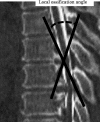Biomechanical study of the spinal cord in thoracic ossification of the posterior longitudinal ligament
- PMID: 22118260
- PMCID: PMC3184490
- DOI: 10.1179/2045772311Y.0000000029
Biomechanical study of the spinal cord in thoracic ossification of the posterior longitudinal ligament
Abstract
Background: Ossification of the posterior longitudinal ligament (OPLL) in the thoracic spine produces myelopathy. This is often progressive and is not affected by conservative treatment. Therefore, decompressive surgery is usually chosen.
Objective: To conduct a stress analysis of the thoracic OPLL.
Methods: The three-dimensional finite element spinal cord model was established. We used local ossification angle (LOA) for the degree of compression of spinal cord. LOA was the medial angle at the intersection between a line from the superior posterior margin at the cranial vertebral body of maximum OPLL to the top of OPLL with beak type, and a line from the lower posterior margin at the caudal vertebral body of the maximum OPLL to the top of OPLL with beak type. LOA 20°, LOA 25°, and LOA 30° compression was applied to the spinal cord in a preoperative model, the posterior decompressive model, and a model for the development of kyphosis.
Results: In a preoperative model, at more than LOA 20° compression, high stress distributions in the spinal cord were observed. In a posterior decompressive model, the stresses were lower than in the preoperative model. In the model for development of kyphosis, high-stress distributions were observed in the spinal cord at more than LOA 20° compression.
Conclusions: Posterior decompression was an effective operative method. However, when the preoperative LOA is more than 20°, it is very likely that symptoms will worsen. If operation is performed at greater than LOA 20°, then correction of kyphosis by fixation of instruments or by forward decompression should be considered.
Figures



References
-
- Matsuyama Y, Yoshihara H, Tsuji T, Sakai Y, Yukawa Y, Nakamura H. Surgical outcome of ossification of the posterior longitudinal ligament (OPLL) of the thoracic spine: implication of the type of ossification and surgical options. J Spinal Disord Tech 2005;18:492–7 - PubMed
-
- Ito K, Yukawa Y, Horie Y, Kato F. Surgical treatment for ossification of posterior longitudinal ligament in thoracic spine: Influence of local ossification angle. Rinsyo Seikeigeka (Japanese) 2008;43:539–42
-
- Cecilia P, Jon S, Richard M. The importance of fluid-structure interaction in spinal trauma models. J Neurotrauma 2011;28:113–25 - PubMed
-
- Ichihara K, Taguchi T, Sakuramoto I, Kawano S, Kawai S. Mechanism of the spinal cord injury and the cervical spondylotic myelopathy: new approach based on the mechanical features of the spinal cord white and gray matter. J Neurosurg 2003;993 suppl:278–85 - PubMed
-
- Tunturi AR. Elasticity of the spinal cord, pia and denticulate ligament in the dog. J Neurosurg 1978;48:975–9 - PubMed
MeSH terms
LinkOut - more resources
Full Text Sources
